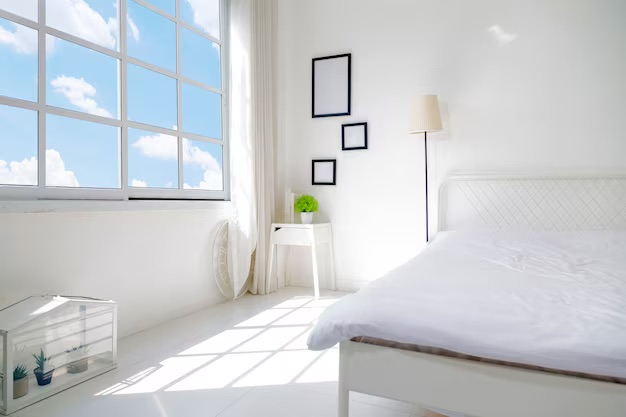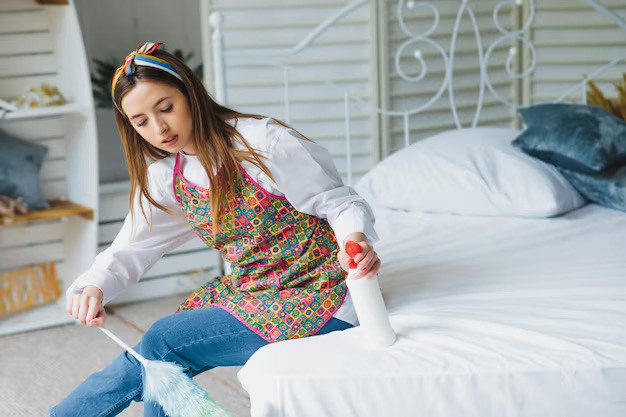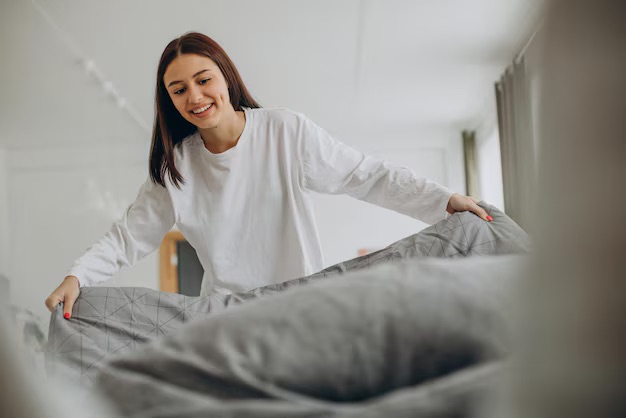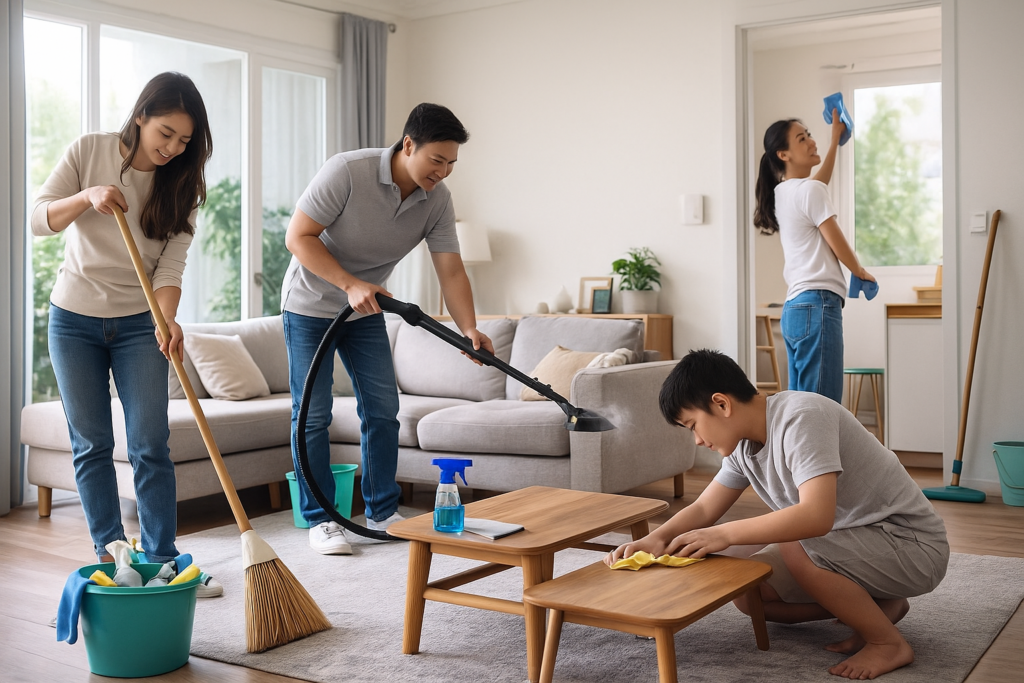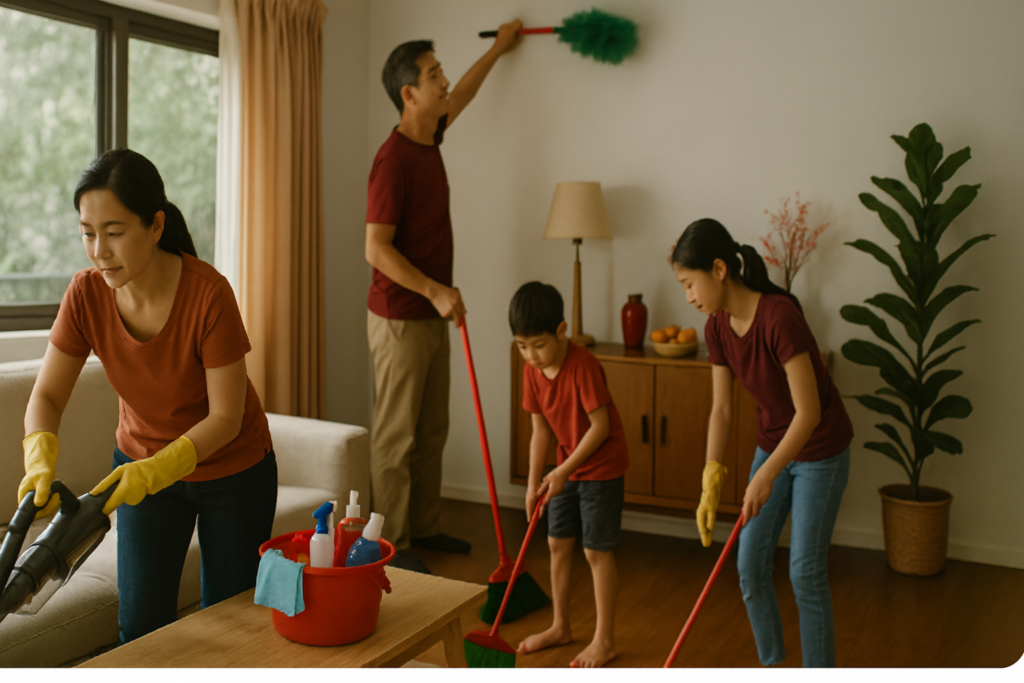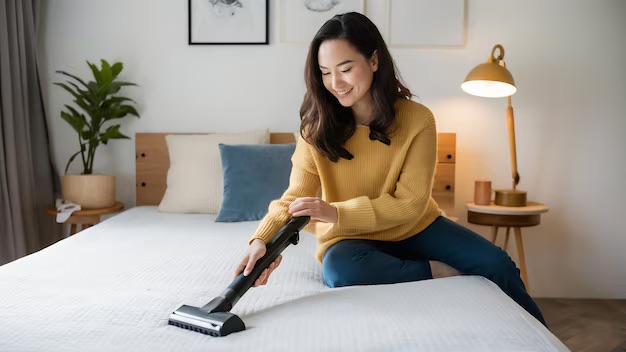
Your bedroom is more than just a place to sleep. It’s your sanctuary and your personal retreat. A clean and organised bedroom can significantly impact your overall well-being. But let’s face it, it’s often one of the most neglected areas in the house when it comes to cleaning.
Alt text: Smiling woman cleaning bed mattress with vacuum cleaner.
This guide is your comprehensive roadmap to transforming your bedroom into a haven of hygiene, relaxation and restful sleep. We’ll walk you through a step-by-step cleaning process, provide essential tips and tricks, and help you tackle common bedroom cleaning challenges. Get ready to revitalise your space and experience the transformative power of a truly clean bedroom.
Why Bedroom Cleaning Is Important
A clean bedroom is not just aesthetically pleasing – it’s an investment in your health and happiness. And the benefits extend far beyond a tidy appearance.
Promotes Better Sleep and Relaxation
Imagine crawling into a bed with crisp, clean sheets on top of it in a room free of clutter. If you’re not suffering from sleeping problems, chances are high that you’ll fall asleep almost immediately in this atmosphere. Indeed, a study found that a clean and organised environment reduces stress levels and promotes a sense of calm. Less stress translates directly to improved sleep quality.
Unfortunately, dust and allergens can disrupt your sleep. Dust mites, pollen and pet dander lurking in your bedding and carpets can trigger allergies and respiratory issues, leading to restless nights. That’s why prioritising bedroom cleanliness is prioritising good sleep!
Reduces Dust, Allergens, and Bacteria
Your bedroom can be a haven for allergens. These common bedroom allergens include:
- Pet dander. Even if your furry friend doesn’t sleep in your bed, pet dander can still circulate in the air and settle on surfaces.
- Mould. Mould growth can occur in damp areas, such as around windows or in poorly ventilated closets.
Regular cleaning, especially vacuuming and dusting, is important for controlling these allergens. Using hypoallergenic bedding and mattress protectors can also make a significant difference.
Prevents Clutter and Maximises Space
Clutter can be overwhelming and contribute to feelings of anxiety and stress. An organised bedroom can promote a sense of peace and control. Research shows that a tidy space can boost productivity and efficiency.
Even in small bedrooms, space-saving techniques can make a big difference. Here are some tips to make the most of your space:
- Use under-bed storage. Utilise storage bins to store out-of-season clothing, extra bedding or books.
- Vertical shelving. Maximise wall space with shelves for books, décor and personal items.
- Multi-functional furniture. Consider installing a bed with built-in drawers or a nightstand with ample storage.
Enhances Air Quality and Eliminates Odours
Poor ventilation can trap stale air and odours in your bedroom. Dust, allergens and volatile organic compounds from cleaning products and furniture can also contribute to poor indoor air quality.
Opening windows regularly to ventilate the room is essential. In addition, consider investing in an air purifier with a HEPA filter to remove allergens and pollutants from the air.
Natural ways to keep your bedroom smelling fresh include:
- Baking soda – Place an open box of baking soda in a closet or under the bed to absorb odours.
- Essential oils – Use a diffuser with your favourite essential oils for a pleasant and natural fragrance.
- Indoor plants – Certain plants, such as aloe vera, rubber plants and snake plants, can help filter air pollutants indoors.
Essential Tools and Cleaning Products for Bedroom Cleaning
Before we dive into cleaning, ensure you have the right tools and products on hand. Here are some must-haves that will make the entire process more efficient.
Must-Have Cleaning Tools
| Item | Function |
|---|---|
| Vacuum cleaner | Removes dust and allergens from carpets, floors, and mattresses. Look for models with HEPA filters, handheld attachments for upholstery, and robotic options for convenience |
| Microfibre cloths and dusters | Picks up dust efficiently without spreading it. Use different cloths for different surfaces to avoid cross-contamination. Use a slightly damp microfibre cloth to remove dust without streaking it all over the surface |
| Storage bins and organisers | Help declutter and maximise space. Choose bins and organisers that fit your specific needs and storage areas |
| Lint roller | Removes pet hair and lint from bedding and upholstery |
| Mattress protector & pillow covers | Help reduce dust mites and dust. Look for breathable, waterproof options |
| Ceiling fan duster | Cleans hard-to-reach ceiling fans and light fixtures. Telescoping dusters allow you to reach high areas safely |
Recommended Cleaning Products
- All-purpose cleaners for nightstands, dressers and headboards
- Fabric fresheners and odour absorbers for bedding and carpets
- Mattress and upholstery cleaners for deep cleaning and stain removal
- Glass cleaners for mirrors and windows
- Air purifiers and natural deodorisers (baking soda, activated charcoal, essential oils) for improving air quality.
Eco-Friendly Cleaners vs Chemical-Based Solutions
When choosing cleaning products, consider the impact on indoor air quality. Eco-friendly cleaners are made with biodegradable ingredients and are free from harsh chemicals, reducing the risk of respiratory irritation and allergies. Chemical-based solutions may contain volatile organic compounds (VOCs) that can pollute indoor air and potentially harm your health.
For a healthier home, opt for eco-friendly options whenever possible. Look for products with certifications like ‘Green Seal’ or ‘EcoLogo’ to ensure they meet environmental standards.
Safety Equipment
Protecting yourself while cleaning is just as important as protecting your furniture. Neglecting safety can lead to health issues and make the cleaning process unpleasant. Here’s a breakdown of essential safety equipment for cleaning your bedroom:
- Gloves – Protecting your hands is paramount when using cleaning products. Different types of gloves, such as cloth, latex and nitrile, offer varying levels of protection. Use cloth gloves if you’re simply dusting furniture, but wear latex and nitrile gloves when handling harsh chemicals.
Always wash your hands thoroughly after removing gloves, even if you haven’t noticed any leaks.
- Masks – Dust, mould and chemical fumes can irritate your respiratory system. A good mask is essential, especially when cleaning areas prone to dust accumulation, like under the bed or inside closets.
- Dust masks (N95 or higher) – These masks filter out at least 95% of airborne particles, protecting you against dust, pollen and mould spores.
- Respirators – For stronger chemicals or mould remediation, consider a respirator with appropriate filters for the specific substances you’re dealing with. Respirators offer a tighter seal and better protection than simple dust masks.
Ensuring a proper fit for your mask or respirator is vital for them to work correctly.
- Eye protection – Splashes from cleaning products can cause serious eye irritation or even damage.
- Safety glasses – Provide a basic level of protection against splashes and debris.
- Goggles – Offer a tighter seal around the eyes, providing better protection against splashes and fumes.
Step-by-Step Guide to Cleaning Your Bedroom
Ready to get started? Follow these steps for a thorough bedroom cleaning:
Step 1: Decluttering and Organising
Before you start cleaning, take some time to declutter.
- Remove unnecessary items from nightstands, dressers and floors.
- Organise books, accessories and daily essentials into storage spaces.
- Sort items into ‘Keep,’ ‘Donate,’ ‘Recycle’ and ‘Discard’ categories.
- Organise personal belongings for easy access.
Step 2: Dusting and Wiping Down Surfaces
- Wipe down bedside tables, dressers, headboards and lamps.
- Use slightly damp microfibre cloths for dust removal – they trap dust instead of just moving it around.
- For wood surfaces, use furniture polish or a wood cleaner. Use glass cleaner for windows and vases, and a metal-safe cleaning solution or polish for metal fixtures.
Step 3: Changing and Refreshing Bed Linens
- Strip the bed and wash sheets, pillowcases and blankets in hot water to kill dust mites.
- Vacuum or shake out pillows and mattress protectors. Mattress and pillow protectors create a barrier against dust mites, allergens and spills, extending the life of your bedding and providing extra protection.
- Rotate and flip the mattress for even wear (follow the manufacturer’s instructions).
If you have sensitive skin, choose detergents and fabric fresheners that are hypoallergenic and fragrance-free. These products are formulated to reduce the risk of irritation and allergic reactions.
Step 4: Vacuuming and Floor Cleaning
- Vacuum carpets and area rugs thoroughly. Clean under your bed, too.
- Use a vacuum with a HEPA filter to trap allergens.
- Mop or clean hardwood and tile flooring with a suitable cleaner.
Step 5: Cleaning Windows and Mirrors
- Use a glass cleaner and a clean microfibre cloth for streak-free results.
- Wipe windows and mirrors in a circular motion, then wipe dry with a clean cloth. Use a microfibre cloth or a crumpled sheet of newspaper to clean windows and mirrors.
- To prevent water spots and dust buildup, clean windows and mirrors on a cloudy day or in the evening.
For more in-depth window cleaning tips, check out our guide here.
Step 6: Deep Cleaning Mattresses and Upholstery
- Vacuum the mattress thoroughly to remove dust mites, dead skin cells and other debris.
- Spot clean stains with a mattress or upholstery cleaner.
- Consider using a steam cleaner to kill dust mites and bacteria.
DIY vs Professional Mattress Cleaning
DIY mattress cleaning can be effective for light stains and general maintenance. However, for deeper stains or severe allergen issues, consider hiring a professional mattress cleaning service. Professionals have the equipment and expertise to thoroughly clean and sanitise your mattress, ensuring a healthier sleep environment.
You can also hire Total Cleanz to clean your upholstery! Learn more about this cleaning service here.
Step 7: Disinfecting High-Touch Surfaces
- Disinfect doorknobs, light switches, remote controls and other high-touch surfaces.
- Use a disinfectant spray or wipe that is effective against bacteria and viruses.
Step 8: Odour Removal and Air Freshening
- Place open boxes of baking soda under the bed, closets and drawers to absorb odours.
- Use a diffuser with essential oils for a pleasant and natural fragrance.
- Consider using an air purifier to improve air quality and eliminate odours.
How to Handle Common Bedroom Cleaning Challenges
No matter how diligent you are, some cleaning challenges are bound to arise. Here’s how to tackle them:
How to Remove Stubborn Stains from Bedding and Furniture
- For wine stains, blot immediately and apply salt or baking soda to absorb the liquid.
- For coffee stains, blot with a clean cloth and apply a mixture of water and vinegar.
- For ink stains, dab with rubbing alcohol and blot with a clean cloth.
- For makeup stains, use a makeup remover wipe or a mixture of water and dish soap.
How to Get Rid of Pet Hair and Odours
- Use a lint roller or pet hair brush to remove pet hair from bedding and upholstery.
- Vacuum frequently; look for vacuums with strong suction, HEPA filters, and attachments specifically designed for removing pet hair.
- Use a pet-friendly odour absorber to eliminate pet odours.
How to Prevent Dust Buildup on Furniture
- Dust regularly with a microfibre cloth.
- Use furniture polish or a wood cleaner on wood surfaces.
- Consider using anti-static sprays to reduce dust accumulation.
How to Maintain Indoor Air Quality in Bedroom
- Open windows regularly to ventilate the room.
- Use an air purifier with a HEPA filter.
- Consider adding indoor plants to help filter air pollutants.
How Often Should You Clean Your Bedroom?
Consistency is key to maintaining a clean and healthy bedroom. Below is the rundown of recommended cleaning tasks and their frequency:
| Task | Frequency |
|---|---|
| Decluttering | As needed |
| Making the bed | Daily |
| Dust surfaces | Weekly |
| Vacuum floors & carpets | Weekly |
| Change bedsheets & pillowcases | Weekly |
| Clean windows & mirrors | Monthly |
| Deep clean mattress | Every 6 months |
| Disinfecting high-touch surfaces | Weekly |
When to Hire Professional Bedroom Cleaning Services
While DIY cleaning is a great way to maintain your bedroom’s cleanliness, sometimes it’s best to call in the professionals.
DIY Cleaning vs Professional Cleaning Services
DIY cleaning can be cost-effective and allows you to customise the cleaning process to your preferences. However, it can be time-consuming and may not be as thorough as professional cleaning. Professional cleaning services offer a deeper clean, saving you time and effort. They use specialised equipment and products to remove stubborn stains, allergens, and odours.
Consider professional services under certain circumstances.
- You have severe dust mite allergies or asthma.
- You have deep stains or odours that won’t go away.
- You lack the time for thorough cleaning.
- You are moving in/out and need a one-time deep clean.
Conclusion
Cleaning your bedroom is an investment in your health, well-being and sleep quality. By following this guide and establishing a regular cleaning schedule, you can create a fresh, organised and relaxing space you’ll love coming home to. Remember to prioritise hygiene, choose the right tools and products, and seek the help of professional cleaners in Singapore when needed.
Consistency is key to a relaxing and clutter-free bedroom. Integrate cleaning into your routine and enjoy the benefits of a clean and organised space.

